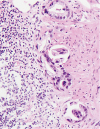1. Coleman CN, Williams CJ, Flint A, Glatstein EJ, Rosenberg SA, Kaplan HS. Hematologic neoplasia in patients treated for Hodgkin's disease. N Engl J Med. 1977; 297:1249–1252.
2. Ioannidis O, Sekouli A, Paraskevas G, Papadimitriou N, Konstantara A, Kotronis A, et al. Metachronous early gastric adenocarcinoma presenting coinstantaneously with complete remission of stage IV gastric MALT lymphoma. Arab J Gastroenterol. 2013; 14:20–23.
3. Nakamura S, Aoyagi K, Iwanaga S, Yao T, Tsuneyoshi M, Fujishima M. Synchronous and metachronous primary gastric lymphoma and adenocarcinoma: a clinicopathological study of 12 patients. Cancer. 1997; 79:1077–1085.
4. Hamaloglu E, Topaloglu S, Ozdemir A, Ozenc A. Synchronous and metachronous occurrence of gastric adenocarcinoma and gastric lymphoma: a review of the literature. World J Gastroenterol. 2006; 12:3564–3574.
5. Inaba K, Kushima R, Murakami N, Kuroda Y, Harada K, Kitaguchi M, et al. Increased risk of gastric adenocarcinoma after treatment of primary gastric diffuse large B-cell lymphoma. BMC Cancer. 2013; 13:499.
6. Copie-Bergman C, Locher C, Levy M, Chaumette MT, Haioun C, Delfau-Larue MH, et al. Metachronous gastric MALT lymphoma and early gastric cancer: is residual lymphoma a risk factor for the development of gastric carcinoma. Ann Oncol. 2005; 16:1232–1236.
7. Leung WK, Lin SR, Ching JY, To KF, Ng EK, Chan FK, et al. Factors predicting progression of gastric intestinal metaplasia: results of a randomised trial on Helicobacter pylori eradication. Gut. 2004; 53:1244–1249.
8. Chow WH, Blaser MJ, Blot WJ, Gammon MD, Vaughan TL, Risch HA, et al. An inverse relation between cagA+ strains of Helicobacter pylori infection and risk of esophageal and gastric cardia adenocarcinoma. Cancer Res. 1998; 58:588–590.
9. Zorlu AF, Atahan IL, Gedikoglu G, Ruacan S, Sayek I, Tekuzman G. Does gastric adenocarcinoma develop after the treatment of gastric lymphoma. J Surg Oncol. 1993; 54:126–131.
10. Pointner R, Schwab G, Königsrainer A, Bodner E, Schmid KW. Gastric stump cancer: etiopathological and clinical aspects. Endoscopy. 1989; 21:115–119.
11. Vardiman JW, Harris NL, Brunning RD. The World Health Organization (WHO) classification of the myeloid neoplasms. Blood. 2002; 100:2292–2302.
12. Neglia JP, Friedman DL, Yasui Y, Mertens AC, Hammond S, Stovall M, et al. Second malignant neoplasms in five-year survivors of childhood cancer: childhood cancer survivor study. J Natl Cancer Inst. 2001; 93:618–629.
13. Al-Akwaa AM, Siddiqui N, Al-Mofleh IA. Primary gastric lymphoma. World J Gastroenterol. 2004; 10:5–11.
14. Haruma K, Suzuki T, Tsuda T, Yoshihara M, Sumii K, Kajiyama G. Evaluation of tumor growth rate in patients with early gastric carcinoma of the elevated type. Gastrointest Radiol. 1991; 16:289–292.







